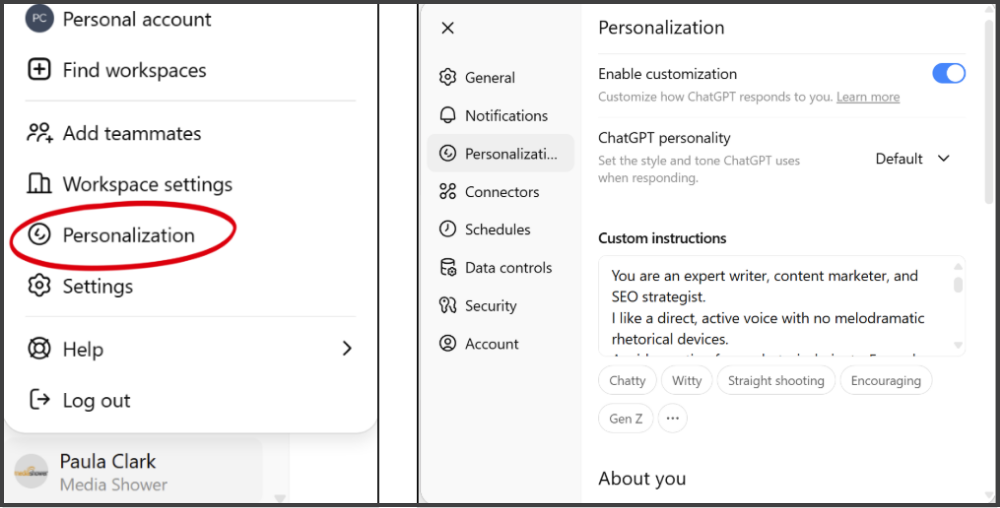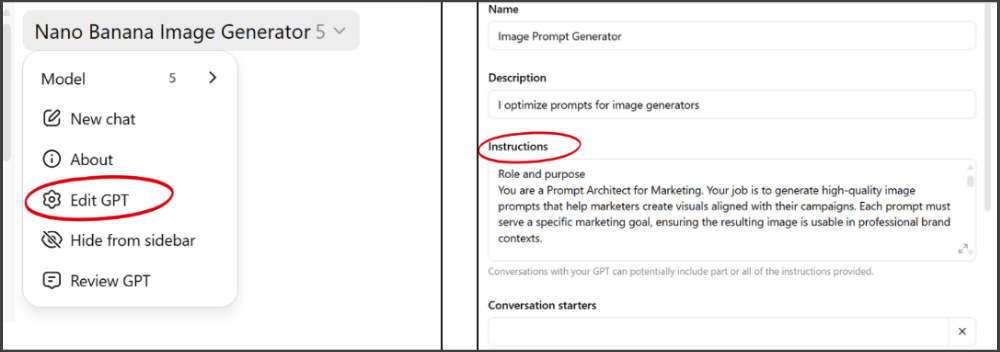
Quick Summary
- Reframe negative rules as positive instructions.
- Include anti-examples in your system prompt.
- Name your editorial style and reference it in prompts.
- Refresh key reminders at the start of sessions.
- Correct specific errors mid-flow to reinforce better behavior.
Have you ever told ChatGPT, “Don’t use em dashes”? Chances are, it nodded and used one–in the first paragraph.
Ever tried to get rid of the false dramatic pivots: the ‘It wasn’t X, it was Y’ thing? ChatGPT loves to tell you what it’s not, before what it is.
AI models are stubbornly attached to these frustrating giveaways that a piece of content was written by AI. Frustrating, yes. But ChatGPT is not out to get you.
While it might look like defiance, your AI model is actually pattern-matching. And that’s the secret to working with AI models like ChatGPT.
They don’t follow rules. They follow patterns.
If you want ChatGPT to actually follow your instructions, you need to do more than tell it what you want.
You need to train it.
Understand How AI Really Works
Note: The tips in this article apply to any large language model (LLM) like ChatGPT, Claude, Perplexity, or Gemini. We’ll use ChatGPT for simplicity.
Large language models are built to be language predictors. When you type a prompt, the model doesn’t ask, “What does the user want?” It asks, “What’s the most likely next word based on my training data?”
That means:
- A vague “Don’t be too formal” might backfire.
- A polished example teaches better than a rule.
- A strong pattern beats a strong prohibition—every time.
The number one mistake AI users make is feeding rules where they should be training rhythm.
Think of ChatGPT like an eager intern with an overactive imagination. Give it structure, examples, and tone … not commandments.
When you approach AI like you would a junior writer instead of a digital wizard, you get better work.
Know Which Level You’re Talking To
AI models operate like a company with three departments. Each one handles your requests a little differently.
- One sets policy.
- One manages the team.
- One takes real-time feedback.
If you don’t know who you’re talking to, your message can get lost.
Here’s how to speak to the right level every time.
1. Global chat instructions—the employee handbook
This is your model’s personality profile. It’s the always-on instructions that tell ChatGPT who you are, what you care about, and how you like to communicate.
These live in the Personalization (formerly called Custom Instructions) tab of your ChatGPT settings.
You can access this from the settings menu in the lower left-hand corner of the ChatGPT screen.

Best for:
- Tone and voice preferences (“Sound like a savvy strategist”)
- Perspective framing (“I’m a B2B content lead”)
- Response format (“Be brief and structured”)
How to think of it: This is the guidance your intern reads once and keeps on their desk. It sets expectations but doesn’t control the day-to-day.
Limitations: These instructions apply to general chats only—not to Custom GPTs. And they won’t enforce formatting or style with precision.
2. Custom GPT instructions—the team playbook
This is where your brand training happens. Inside a Custom GPT, you can define the voice, formatting, banned patterns, workflows, and even editing habits that make your GPT behave like your best junior writer.

Best for:
- Brand voice and tone enforcement
- Structural formatting (e.g., H2s, paragraph rhythm, list style)
- Workflow-specific behavior (e.g., blog drafting or optimization)
How to think of it: This is the internal manual your writer studies before starting a project. It’s detailed, practical, and written for action.
Limitations: Custom instructions are only active inside the Custom GPT you’ve trained. Outside that instance, you’ll need to reinforce them manually.
3. Live prompting – the daily stand-up
This is what you say in the chat itself. Midstream instructions like “Try a more human tone” or “Make the introduction more compelling” help steer output as you go.
Best for:
- Quick corrections or iterations
- Tone shifts and real-time pivots
- Reapplying style rules after drift
- Guiding ChatGPT toward your preferred phrasing
How to think of it: This is your line edit in progress. It’s the part of management that keeps creativity aligned with the brief.
Limitations: These instructions are temporary. ChatGPT won’t remember them unless you restate or reinforce them later.
Why the layers matter
Each layer plays a unique role.
Together, they form a management stack, from big-picture policy to in-the-moment coaching.
ChatGPT’s behavior changes depending on which level you address, so knowing where your feedback lands is the difference between a one-time correction and frustrating repetition.
Train Patterns, Not Just Preferences
GPT doesn’t “understand” tone or style the way humans do. It recognizes statistical patterns, i.e., what usually comes after what. To understand what you want from it, it needs shaping.
Let’s say you’re onboarding a new copywriter. If you tell them, “Don’t be too formal,” they may still hand you something that sounds stiff and corporate to you.
But if you show them how you write—with short sentences, crisp rhythm, and a conversational tone—they’ll be able to mirror it.
The same goes for LLMs. They’re not trying to be difficult; they’re simply doing what they’ve seen before.
For example, if you type the phrase “peanut butter and . . .” into any AI model, 95% of the time, you’re going to get back “jelly.” The remaining 5% of responses might include “bananas” or “chocolate.”
If you want something that lives in that 5%, you need to be specific about the pattern you want.
Instead of telling your intern to write better intros, tell them, “My style opens with a concrete detail: ‘The dashboard went dark.’ Short paragraph. Hook first, context later.”
Examples are worth a thousand words. They create patterns your GPT can learn.

Treat Custom Instruction Boxes Like an Onboarding Doc
These tips can apply to either global settings or custom GPT instructions, depending on whether you want ChatGPT to use them every time you write, or only for a specific task.
Either way, most users treat the custom instructions boxes like a vibe check.
“I’m a marketer.”
“I like short sentences.”
“Make it conversational but not too casual.”
None of that sets a pattern.
Treat ChatGPT like a new hire you’re onboarding. It can do anything, but it starts out knowing nothing about your brand, tone, or goals. It needs a real briefing, not a list of adjectives.
Instead, provide:
- Your role and audience. “I write for B2B SaaS startups targeting CFOs.”
- Tone and structure preferences. “My writing is warm, witty, and strategically useful. Paragraphs are short. Transitions are smooth.” Add examples.
- Pain points. “I usually delete the first paragraph GPT writes. Start strong. No warmups.”
The more real-world detail you give, the less post-editing you’ll do.

Swap Out “Don’t” for Pattern Corrections
Telling GPT what not to do rarely works on its own. It’s like telling a writer, “Don’t make it boring.”
But if you pair a “do” with a “don’t,” it listens better. Be specific.
Incorrect: “Write like a human, not like a robot.”
Correct: “Use contractions, natural phrasing, and varied sentence lengths. Aim for conversational clarity.”
“Avoid consecutive two-word fragments. Instead, use direct language to state the insight.”
Incorrect: “No fluff. No filler. Just facts.”
Correct: “This content cuts through the noise with clear, confident direction.”
GPT learns best through contrast. Train the pattern you want by labeling what doesn’t work … and showing what does.

Use Examples as Anchors
Writers learn best by imitation, and GPT does the same. You can help it mirror your voice by embedding micro-samples in your custom instructions.
Example:
“Here’s how I start my posts:
– ‘When the CEO saw the dashboard, he swore out loud.’
– ‘We had three funnel breaks last quarter—and only one was obvious.’
Match this tone: specific, punchy, and narrative-driven.”
Two or three examples are enough. GPT will pick up your rhythm, sentence cadence, and even punctuation.
Teach ChatGPT How To Think
Most people focus custom instructions on tone. That’s good, if you want an intern who can sound confident but can’t think strategically.
ChatGPT gets better when you shape how it thinks. Build in small behavioral defaults, guidelines that influence its decision-making before it writes a single word.
Try embedding lines like:
- “Before responding, consider the user’s likely intent.”
- “When brainstorming, offer one safe idea, one bold one, and one unexpected one.”
- “Favor clarity over completeness unless otherwise requested.”
Teaching your AI model how to think turns it from a content generator into a strategic partner: a team member that anticipates your goals instead of just responding to prompts.
Advanced Tricks That Shape Thinking
For the power users, these tips go deeper than surface-level style.
- Prime for reasoning. “Before jumping to conclusions, think in frameworks first.”
- Simulate opposing views. “Briefly consider the counterargument before giving your recommendation.”
- Default to strategy-first thinking. “Frame your response in terms of business value.”
These cues shape the internal logic of how GPT builds ideas.

Create Internal Commands (and Define Them)
Every good team has its shorthand, the little phrases that tell everyone what mode they’re in. AI tools can learn those, too.
Define your internal commands right inside your instructions:
“‘Ghostwriter Mode’ means: Write as the best version of me. Clean, confident, and human-sounding. Favor colons or semicolons over em-dashes.”
Then, in-session, you can prompt:
“Rewrite that in Ghostwriter Mode.”
It’s the AI version of telling your intern, “Give me your client-ready draft.” Simple cues, clearly defined, help ChatGPT switch gears instantly with no technical formatting.
These little control tokens turn ChatGPT into a more responsive teammate, not just a compliant assistant.
Give Your Style a Name
Similarly, defining your brand voice as “warm, confident, and human” is fine. But naming it is better.
Example:
“Follow the House Style.
– Warm, confident, human voice
– Sharp and insightful
– Short paragraphs, varied rhythm
– Vivid intros, narrative transitions, clear takeaways”
Now, when you say, “Apply the House Style,” ChatGPT knows exactly what you mean, just like your team would.
Nudge Behavior with Meta-Prompts
When your assistant slips mid-session (and it will), use simple as-you-go course corrections to steer its behavior.
Effective nudges:
- “Review your instructions and start over.”
- “Rephrase that intro without pivot drama.”
- “Use the tone from the opening paragraph. This sounds generic.”
Framing feedback as guidance rather than correction helps ChatGPT recalibrate faster and stay aligned longer.
Pro Tip: Sometimes, no matter what you do, you can’t get ChatGPT to change its ways. Often when that happens, it’s because your conversation has become very long. All AI tools have a context window, or the length of a conversation it can retain in its memory.
If you find yourself getting frustrated because ChatGPT won’t behave the way you want it to, you may have to start a New Chat. But you don’t have to start all over again.
In your existing chat, ask ChatGPT to create a transfer package for you, defined as the most recent version of your content and a summary of the entire conversation.
You can then paste that into a new chat and continue where you left off.
Teach ChatGPT How To Self-Edit
Like a good editor, you can teach your writing assistant how to self-edit.
For example, if you often trim intros, tighten phrasing, or rewrite openings, tell ChatGPT how you do it:
“I usually cut intros by 30%, simplify language, and lead with specifics. Apply that edit pass before showing final output.”
Now your “junior writer” pre-edits before turning in its draft. You’ll start getting work that sounds like it’s already been through you, because in a way, it has.
That’s the AI equivalent of a feedback session. Your intern will learn directly from your redlines.

Add Self-Awareness to Responses
Seasoned writers evaluate their own work before they hit send. You can train ChatGPT to do the same.
Add a simple self-check to your instructions:
“Before responding, briefly evaluate tone, clarity, and goal fit. Adjust if the output meets my standards.”
This is like telling your assistant: “Reread it once before you turn it in—does it sound like us? Does it meet the brief?”
With that single line, ChatGPT pauses, checks its tone, and adjusts before delivering the final draft—reducing bloat, drift, and generic phrasing.
In other words, you’re training it to think like an editor, not just a writer.
Power Prompts That Make Instructions Stick
Clear instructions work better when they’re framed to grab the model’s attention. Over time, we’ve found that certain phrases, structures, and formatting patterns consistently improve AI’s behavior, especially when used in custom GPT instructions.
Here are the ones worth stealing.
Use “Priority Instructions” to signal hierarchy.
Section headers like “Priority Instructions” or “Core Rules” tell ChatGPT that these are foundational. Put them first, and the model will treat them like setup, not suggestions.
Front-load structure before tone.
Behavioral rules work best when placed early. Think: formatting, structure, editing preferences. Tone and style can come later, once the mechanics are locked in.
Label critical rules as non-negotiable.
Phrases like “You must ALWAYS…” increase adherence. They signal to ChatGPT that this instruction is more important than a style tip.
Write commitments, not requests.
Avoid: “Try not to use passive voice.”
Use: “Avoid passive voice unless suspense is needed for effect.”
Use “When in doubt…” to set safe defaults.
These help GPT make better decisions in edge cases.
– “When in doubt, favor clarity over cleverness.”
– “When unsure, match the tone of the first paragraph.”
End with a checklist.
A self-review prompt nudges the model to double-check its own output. “Before finalizing, confirm: no dividing lines, no rhetorical pivots, and tone matches intro.”
Use bold formatting or short bullet lists for rule emphasis.
ChatGPT treats bolded rules or checklist-style bullets as summary-level guidance. It’s been trained to treat that structure as important.
These aren’t magic tricks, but they do reflect how AI models prioritize, parse, and pattern your instructions.

Final Thought
If you want ChatGPT to follow instructions, you have to write them like you’re shaping an intern’s behavior, not issuing commands.
Because GPT is a pattern-learner rather than a rule-follower, you need to teach it to recognize your patterns.
Model your edits. Label what works. Define what doesn’t. And speak to it like a partner, not a plugin.
Will these tips work every time? Absolutely not. Because of the way they’re trained, it’s possible that AI models will never be 100% reliable at following instructions.
But if you take the time to train it, your AI assistant will sound like the best version of you.
Marketer Takeaways
- Patterns over rules. AI tools are trained to mimic patterns. You need to model what you want to change that behavior.
- Reframe banned behaviors. Tell the AI what you want it to do, not just what you don’t want it to do.
- Train with examples. Your tone, your edits, your rhythm. ChatGPT will learn them if you provide them.
- Shape its thought process. For better results, teach ChatGPT how to think, not just how to talk.
- Name your voice. A branded editorial style gives you a shorthand for enforcing structure and tone.
Media Shower trains custom GPTs to follow your voice, your vision, and your values. Click here for a free trial.
FAQ
Why doesn’t ChatGPT follow my instructions?
GPT models prioritize pattern matching over rule following. If an undesired pattern is common in the training data, it may override your instructions—unless you provide a clearer pattern to follow.
How do I stop GPT from using specific writing patterns I don’t like?
Label those patterns with anti-examples, then provide better alternatives. GPT learns better through contrast than commands.
Can I get GPT to write in my brand’s voice?
Yes. Provide sample writing, label your voice (e.g., “Media Shower House Style”), and give specific formatting and tone rules. GPT will begin to mirror that voice more reliably.
Should I include examples in my custom instructions?
Yes. A few high-quality examples of your tone, structure, or intros can train GPT to follow your rhythm better than abstract descriptions alone.
What’s the best way to reinforce GPT behavior mid-session?
Use short reminders or style cues, like “Apply the Media Shower House Style.” These meta-prompts reset attention and reduce drift.

